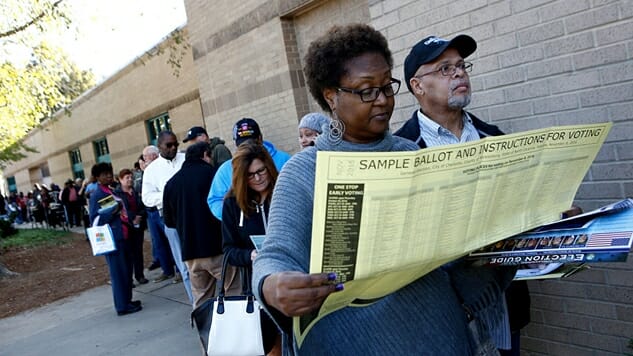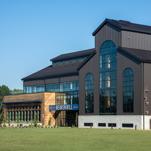What Are Early Voting Numbers Across the Country Telling Us?
Photo by Brian Blanco/Getty
I want to preface this with a couple caveats: total voting figures are extremely difficult to extrapolate from early voting statistics. In 2016, NPR published an article that cited a study which found that early voting actually decreases turnout (amongst others that found it slightly, but meaningfully, increases turnout). Plus, these large turnout numbers are not automatically indicative of an advantage for Democrats, as mail-in voting skews Republican, while in-person tilts Democratic. The truth is far more nuanced. That said, there are largely encouraging early voting figures for Democrats, and good news for Republicans in a couple key states.
Florida
Florida voting has now surpassed the entire 2014 in-person early voting total, and the entire pre-election day total.
Total: 3,414,365
Republicans: 1,431,655 (41.9%)
Democrats: 1,368,718 (40.1%)
NPA/Minor: 613,992 (18%)Republican edge is 62,937 (+1.8%)
In 2014 it was ~ 133K pic.twitter.com/Uj55OVyAPl— Steve Schale (@steveschale) October 31, 2018
The gains that Democrats are making in Florida come amongst the strongest Democratic voter bloc: African Americans. Per The Miami Herald:
[Anita] Coolie’s election-season visit to the North Dade library in Miami Gardens may extend a notable streak for the only early-voting site in Florida’s largest black-majority city. Since the weekend began, the library is the only one out of the county’s 28 early-voting sites to actually see more voters than it did during the same four-day stretch during the 2016 presidential election.
Elizabeth Judd told The Herald that “Most people are coming in here to vote for [Democratic candidate for Governor, Andrew] Gillum” and that “everyone else is an afterthought.” This enthusiasm also extends to young people, as CNN noted that “the share of younger people voting early in Texas and Georgia is far outpacing anything seen at this point during the last midterm election, in 2014.”
Texas
Nearly two weeks ago, The Houston Chronicle reported that the first day of early voting in Houston was “shocking,” noting that “Nearly 2,000 people stood in line outside of the Metropolitan Multi-Service Center on West Gray near River Oaks in a scene that looked more like a Black Friday shopping morning.”
The Texas Tribune reported that “Texas surpassed its 2014 early voting turnout in five days.” Nearly four million Texans have already voted. In the 30 counties where 78% of registered Texas voters live, 32.4% have already voted, which is a staggering figure considering that 33.5% of registered voters in those 30 counties voted in total during the 2014 midterms.
Georgia
Speaking of deep red states with inspirational Democratic candidates, Stacey Abrams has Oprah and Will Ferrell knocking on doors, trying to overcome Republican Brian Kemp’s massive voter disenfranchisement operation.
Vox noted that while the general rule is that large gains amongst racial/ethnic groups compared to the others do not happen often, “That said, there are some exceptions to this general rule. One that might work in favor of Democrats is in Georgia. While early voting has dropped among all three groups compared to this point in 2016, the drop among white voters is greater than it is for black and Latino voters. The relatively strong turnout patterns for people of color in Georgia may bode well for the gubernatorial campaign of Stacey Abrams; yet even here, we do not see higher rates of early voting for black people than for white people, like we did in 2012.”
That said, a significant share of white people in Georgia are young people, and youth voter turnout so far is four times as high as it was in 2014. There is no doubt that the enthusiasm seen amongst young people and minorities in Texas and Georgia is in some way related to the exciting Democratic candidates with aggressively liberal policies on the ballot. There is a lesson here to be learned for Democrats in these red states.
Nevada
One of the strongest turnout days yet for Nevada Dems. But not unexpected: the final two days of early voting usually see an increase in the number of votes cast, which helps Dems net votes in Clark; expect even more of the same tomorrow. https://t.co/GUTbLoCXtH
— Taniel (@Taniel) November 2, 2018
Jon Ralston, who is widely regarded as the oracle of Nevada politics, wrote in the Nevada Independent that these are the likely outcomes based on the huge early/mail numbers:
U.S. Senate: Toss-up
Gov: Toss-up
CD3: Slight lean D
CD4: Likely D
State Senate: D at least 12, chance at 14
Assembly: D at least 26, chance at 28
Arizona
Now here comes the bad news for Democrats: early voting is way up in Arizona, but it’s Republicans who are making news here. A week ago, AZ Central reported that Republican returns of mail-in ballots outpaced Democrats by 11%. This week, Data Orbital, a political consultant in Phoenix, wrote that old voters outnumber young and middle-aged voters by a 2:1 margin, and that the Republicans have a larger share of early voting (by 3%) than they did at this same point in 2016. This is likely thanks in part to Martha McSally being a Senate candidate that Republicans are genuinely excited about.
Tennessee
Call part of this the Taylor Swift effect. Perhaps the biggest pop star in the world publicly stepped into politics for the first time, and endorsed Democrat Phil Bresden over Republican Marsha Blackburn in her home state. While that clearly isn’t the main reason why Tennessee voting is way up, it’s impossible to ignore the unprecedented endorsement from a woman with nearly 30 million more Twitter followers than President Trump. The Tennessean reported that early voting has surpassed one million people, and it remains at a “historic level.” Turnout is nearly three-times that of 2014, and Williamson County Election Administrator Chad Gray told the Tennessean that “This really is trending more like presidential turnout, as far as when voters are voting” and “At this point, I think we’re probably going to get close to 46 percent (for early voting).”
However, like Arizona, the story in this deep red state looks to be Republican enthusiasm, as NBC News wrote that “63 percent of early voters had a Republican affiliation, compared with 30 percent who had a Democratic affiliation and 7 percent who were not affiliated with either party.”
Maryland
We’ll end on a high note, as unlike every other state on this list, Maryland doesn’t really have a race that has captured national attention. There is a clear correlation of some degree between national spotlight and high early voter turnout, yet here we see record turnout without the national attention. The Washington Post noted that “Just about twice as many people voted early in Maryland and Virginia this election season, with turnout eclipsing the entire 2014 vote total in some jurisdictions.”
The Baltimore Sun has a lot of interesting figures in their article today, but this is perhaps the most encouraging for Maryland Democrats:
Democrats bested Republicans in new registrations 2,430 to 617 — that’s close to a 4-1 margin. The first time Maryland voters could register and vote the same day during early voting was in 2016, when 7,884 people registered during the early-voting period for the general election.
As 2016 should have taught us, don’t take any early voting figures for granted—positive or otherwise. If you don’t vote, that detracts from any positive early voting gains, so make sure you express your fundamental democratic right and vote for Democrats, lest you enable the Republicans to continue to try to take your democracy away from you.
Jacob Weindling is a staff writer for Paste politics. Follow him on Twitter at @Jakeweindling.







































